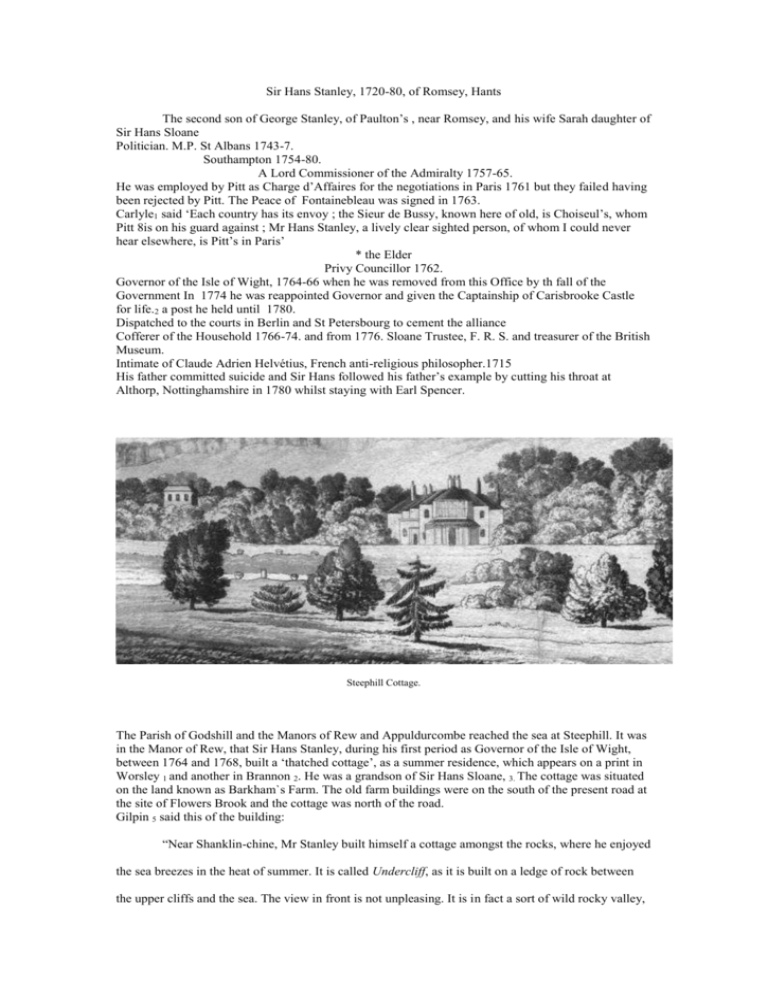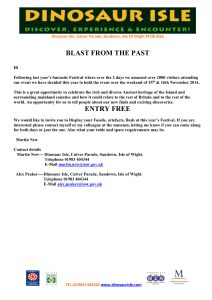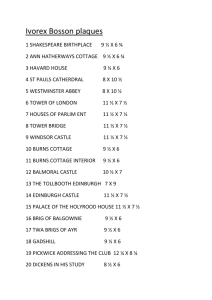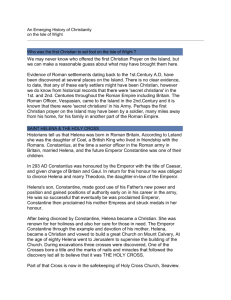Sir Hans Stanley. - Isle of Wight Enthusiast
advertisement

Sir Hans Stanley, 1720-80, of Romsey, Hants The second son of George Stanley, of Paulton’s , near Romsey, and his wife Sarah daughter of Sir Hans Sloane Politician. M.P. St Albans 1743-7. Southampton 1754-80. A Lord Commissioner of the Admiralty 1757-65. He was employed by Pitt as Charge d’Affaires for the negotiations in Paris 1761 but they failed having been rejected by Pitt. The Peace of Fontainebleau was signed in 1763. Carlyle1 said ‘Each country has its envoy ; the Sieur de Bussy, known here of old, is Choiseul’s, whom Pitt 8is on his guard against ; Mr Hans Stanley, a lively clear sighted person, of whom I could never hear elsewhere, is Pitt’s in Paris’ * the Elder Privy Councillor 1762. Governor of the Isle of Wight, 1764-66 when he was removed from this Office by th fall of the Government In 1774 he was reappointed Governor and given the Captainship of Carisbrooke Castle for life.2 a post he held until 1780. Dispatched to the courts in Berlin and St Petersbourg to cement the alliance Cofferer of the Household 1766-74. and from 1776. Sloane Trustee, F. R. S. and treasurer of the British Museum. Intimate of Claude Adrien Helvétius, French anti-religious philosopher.1715 His father committed suicide and Sir Hans followed his father’s example by cutting his throat at Althorp, Nottinghamshire in 1780 whilst staying with Earl Spencer. Steephill Cottage. The Parish of Godshill and the Manors of Rew and Appuldurcombe reached the sea at Steephill. It was in the Manor of Rew, that Sir Hans Stanley, during his first period as Governor of the Isle of Wight, between 1764 and 1768, built a ‘thatched cottage’, as a summer residence, which appears on a print in Worsley 1 and another in Brannon 2. He was a grandson of Sir Hans Sloane, 3. The cottage was situated on the land known as Barkham`s Farm. The old farm buildings were on the south of the present road at the site of Flowers Brook and the cottage was north of the road. Gilpin 5 said this of the building: “Near Shanklin-chine, Mr Stanley built himself a cottage amongst the rocks, where he enjoyed the sea breezes in the heat of summer. It is called Undercliff, as it is built on a ledge of rock between the upper cliffs and the sea. The view in front is not unpleasing. It is in fact a sort of wild rocky valley, about a quarter of a mile across, hanging over the sea; which appears abruptly beyond it, without the intervention of any middle ground. It exhibits generally a moving picture, presenting the track which ships, coasting the Island, commonly take…… “ But though the situation of Undercliff or Steephill is pleasing , we could so much for what is called the cottage. It is covered indeed by thatch; but it makes no more a cottage than ruffles would make a clown, a gentleman, or a mealy hat turn a laced beau into a miller. We every where see the appendages of a junket and good living. Who would expect a fountain bubbling up under the windows of a cottage, into an elegant carved shell, to cool wine? The thing is beautiful, but out of place.” He also owned property on the Island at Limerstone and Shalcombe After he committed suicide in 1780, unmarried, his sisters, Lady Mendip and Mrs Doyley inherited his property. Lady Mendip died and Mrs Doyley, being an old lady of ninety and childless gave it to their nephew, Hans Sloane, of South Stoneham, Hants, who was M.P. for Newport in 1768. 6 and 1774. He sold it to the Hon. Wilbraham Tollemache, later the 6th. Earl of Dysart. Hans Sloane S later took the name Sloane-Stanley. Hassell 9 , in 1790, says of the grounds “ The entrance leading from the gate to the house is lined on both sides by lofty elms and ashes which form the avenue that reaches almost to the door...where a different taste is seen in the surrounding flowers and shrubs.” and “On the left hand before we reached the house stood an urn and on the right hand a chair formed of rough branches of trees, which, though simple, was curious.” One principal view from it is to the west; where a bow window projects, that like the roofs of all the other parts, has only humble thatch for its covering. A pleasing lawn lies before it, which gradually declining; present the whole range of St Lawrence on one side and the extremity of the ocean on the other. On the right side at the bottom of the lawn you pass a wicket that leads to a garden which by its situation cannot fail of being productive.” Wyndham 7 says “ Just before the windows of the west front, a beautiful spring of most transparent water, keep a large stone basin, in the form of a scallop shell, perpetually full. I should have pointed out that we passed through a little parterred flower garden in leaving the cottage of Steephill in which a beautiful specimen of Mr Coad`s (sic)*stone manufactury ( see note ) both for its workmanship and durability was seen. It is a large and noble vase, after the antique ..” *Coade Stone was invented by George and Eleanor Coade at their Lambeth Factory in 1769, managed in its greatest period by their daughter, Eleanor, also known as Mrs Coade, until 1820. It is a ceramic artificial stone, which is unglazed and resistant to weathering. It was used by leading architects of the time for Neoclassical style ornaments based on Greek and Roman antiquities and for upwards of 15 years yet it retains all the original sharpness of its alto-releivos without injury. Old John Green, the Parish Clerk of St Lawrence, says in his Memoirs, 8 “ I have been informed that the Earl of Dysart’s Cottage, that stood where Steephill Castle now stands, was built by a gentleman whose name was Standley, the then governor of the Isle of Wight, and in 1783 it was partly burnt by a thoughtless person, who was assisting the cook to get dinner for a large party of French gentlemen visitors. To hasten the fire for cooking she threw some dripping on the grate, which caused a furious blaze and set the kitchen on fire, and the man who was on the roof at work, finding the lead was melting, jumped off to escape the fire and broke his leg. It was said that the Governor was treacherous and a confederate with the French, and sometime afterwards he was like to be proved a traitor, and he destroyed himself in a wood, in the County of Nottingham, by cutting his throat in a dreadful manner. Two women met him near the place where he entered the wood, and soon after they passed by him they heard a dismal groan, and went to see what was the matter, and found him dying in a dreadful state. Part of the premises belonging to Steephill Castle was pasture land before the Governor built his cottage. It belonged to a farm called Barkham`s (the owners name). The farm and the other buildings were situated below the road opposite the Castle”. When the Earl of Dysart died, his sister Lady Louisa Manners, sold the estate to Mr Hambrough in 1828, who demolished the cottage to make way for Steephill Castle, built between 1828 and 1832 Mrs Groves, was the licensee of a popular rustic Inn in the grounds of Steephill Cottage. Hassell 9 ,also says of this “ Parties frequently come to the Inn at Steephill to dine; when, though they might not find the sumptuous entertainment of a modern hotel they will meet with every convenience of serving up a cold collation. Even in the recluse and humble situation, a ray of taste is visible. The proprietors have encouraged the branches of a fig tree to repose itself on an artificial support, thereby forming a kind of canopy, which spread over a daisy mounted carpet, serves as a pleasing and agreeable receptacle, in which parties dine al fresco .On the opposite side a venerable walnut spreads its branches over the seats and likewise shelters the cheerful guests from the scorching rays of the sun.” However, when the site was developed she was given land to build ‘The New Inn’, which later became Hillside Hotel, on the south face of St Boniface Down. 10 From a paedestrian Tour in the Isle of Wight 1799 After we arrived at the Inn at a Steephill we found no bed to receive us, for different parties had already taken possession of those that were in the house; in addition to this we were obliged to put up with such homely fare has offered asked in the tap room, and here we solaced ourselves after that that teak we had undergone with the conversation of those that composed the vile group of the taproom. After some persuasion the mistress of the house furnished us with a bed in the kitchen, but we found it necessary to fill up the long and tedious vacancy from 6 o'clock until 12, before we were permitted to close our eyes; fortunately a party of Welch soldiers were stationed at the house and they amused us with singing several of their provincial songs with true Cambrian spirit. The parish of St Lawrence's much frequented by travellers of every description, who is here indulge themselves with a ramble among the most rural and picturesque scenes page 24. replete with every view that renders the landscape are charming. From its peculiar aspect, from its bordering on this sea, people of taste had made it their summer’s residents, and directed little villas in such places as are remarkable for their prospects; hence the parish became ornamented with elegant structures and its original wild miss reduced to some order and regularity. There is only one public house in the parish, and I believe, this is going to be removed, the proprietors will these those beautiful villas are unwilling to expose their gardens and pleasure grounds to the inspection of those inquisitive strangers who make the public house their residents to their curiosity is satiated. The it has often been lamented there is no better accommodation for the parties to visit, this romantic spot, and who are obliged to put up with such fare as the place affords; if a substantial inn were elected, with several lodging rooms it would obviate this inconvenience, and would answer the intention, but no such has been yet attempted; many are discouraged from undertaking of this nature, as the land can only be obtained by leases of certain terms of years, length and according to the money which is paid by the tenant. The whole of this parish is reported to have sunk below the joining hill, and the left as a ridge of rocks formed of various strata piled upon each other. Between the strata where the sand is mouldering away in which daws build their nests and a rear their young with security. At the Earl of Dysart's Villa, a fine transparent a stream is conducted to a shell, on the green before the parlour window. From the gardens the rocks or extreme the grotesque and lift their rugged fronts over the tops of the trees; great attention has been paid to ornament the highly favoured spot with appropriate rural scenery. There is a little building, in imitation of a hermitage in the highest part of the gardens, and almost enveloped among the rocks and foliage of the trees, which climb around them; whence there is a bold view of the sea, and all the changes it undergoes are distinctly seen. Immediately opposite the public house is a huge rock standing on a verge of the cliff; Accident having produced a cavity, care has been taking to enlarge it for the reception of the centinel who were the keeps guard in the night I visited the centinel on duty, who proved to be a soldier in the Flintshire militia and; after some previous discourse, I prevailed upon him to tell me the circumstances of his life and was much pleased with his unvarnished tales. And luckily I touched upon his lineage and imagined a person in this situation would think but little of his ancestors; however, I was mistaken and the honest Cambrian smoking he short pipe, with emotion told me, he was a zealous in the cause of his pedigree, and that he could trace his ancestry back as far as he pleased, even as far as Rice ap Owen, the founder of the family. I was satisfied, and begged him to desist. The following poem entitled ‘Steephill’ appeared in the July edition of the ‘Isle of Wight Magazine’ in 1799. Rearing amid the cumbent air their heads, Rock piled on rock, theatrically spreads, With twining ivy from the chasms bound, And oozing moss their lofty summits crowned. Beneath a range of snowy native wall, Through which Pennacian streams resplendent fall ; Where grottos formed by times fantastic hand Present a prospect of a fairy land. .. How gently slopes - how rugged lies the scene . Heav`ns glowing arch, and ocean`s stretching plainWhere ships at distance seem to touch the skies, But near home, to floating castles rise Aloft in air, the gamesome porpoise striven Or sparkling trails, or in the fluid dives. Loud ‘gainst the steep the furious surges beat, Which cavered rocks in mimic sounds repeat; Redoubl`d strength th` impetuous flood acquires, And foaming cataracts blend in liquid fires; Th` extended bulwarks midst the hostile roar, Unshaken stand the guardians of the shore. Thrice happy Dysart, whom the stars ordain, The favoured master of the bounteous scene. 1. Carlyle. Frederick ,the Great vol. iv p.204. 2. Boucher James, E. The Isle of Wight Letters Archaeological and Historical. 1896. 1 Worsley, Sir Richard. The History of the Isle of Wight. 2 Brannon, George. Views in the Isle of Wight 1822- 3. Sir Hans Sloane, 1660- 1753. Studied in London, Montpelier and Paris. M.D. Orange 1683. Lived at Thomas Sydenham’s house and was encouraged by him to practise. Physician to the Duke of Albemarle, Governor of Jamaica 1687-9. Secretary of the Royal Society 1683- 1713 President of the Royal Society 1727- 35.to succeed Newton. P.R.C.P. 1719-35 Purchased the manor of Chelsea 1712. Founded the Botanic Garden at Chelsea.1721 He attended Queen Anne in 1712. Physician to King George II. First Baronet. 1716 His collections were purchased for the Nation and housed at Montague House, which became the British Museum. 5 Gilpin, William. Observations on the Western parts of England relative chiefly to Picturesque Beauty 1798. p.309 6. Black, Sir Frederick. A Parliamentary History of the Isle of Wight. 1929. . 7. Wyndham, J.P. A Picture of the Isle of Wight. 1794 8. The Memoirs of Old John Green. The Mercury, June and July 1890 and Champion Alan. ‘I Remember, I Remember. 1989. 9. Hassell, J. Tour of the Isle of Wight, 1790. Vol. ii, p.3. Governor Hans Stanley. The melancholy, sable-suited figure whose portrait, again by Reynolds, is next in the display [ at Carisbrooke Castle in 1974 ], is HANS STANLEY (1764-1767 and 1770-1780), the first since Girling to be without any title, military or civil, except that of his office. A Hampshire man, from Paultons, near Ower, his career lay in politics and diplomacy. A Member of Parliament for the greater part of his career, he was also for several years one of the Lords of the Admiralty, Charge d'Affaires in Paris, Privy Councillor, Cofferer of the Household, a scholar who left manuscripts on classical subjects, he was among the first Trustees of the Sloane and British Museums, and an intimate of Helvetius. A memory of him lingers in the Island, where he built Steephill Cottage, near Ventnor. A bachelor to the end of his days, he never laughed, and was described as awkward, ungracious and eccentric, although Lady Hervey, who knew him, thought him 'very ingenious, sensible, knowing, conversible . . . His melancholy in the end overtook him, and in the gardens at Althorp, one day in 1780, he resolved his inner conflicts by cutting his throat. From : Lords, Captains and Governors of the Isle of Wight. D.O.E. 1974. This is a booklet about the Governors etc. of the IOW Held at Carisbrook Castle gatehouse in 1974








